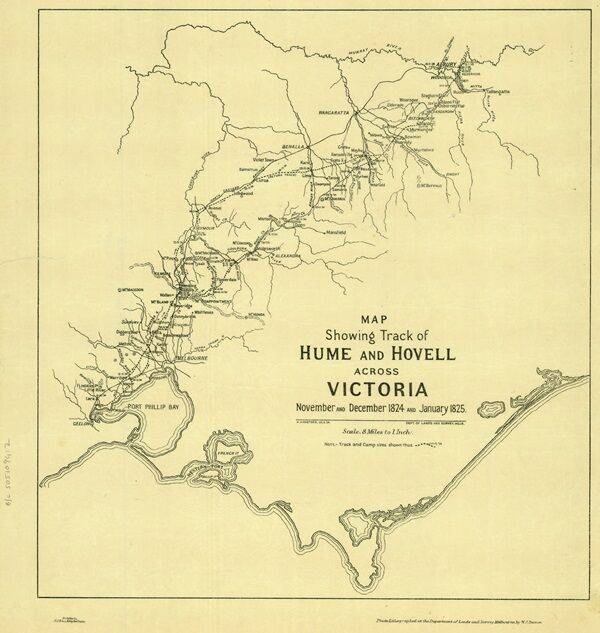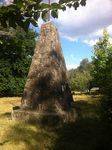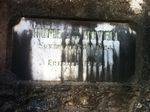
Home » Themes » Landscape » Exploration
Hume & Hovell Print Page 

The cairn at the old school site commemorates Hume and Hovell who passed through the area in 1824. The cairn was unveiled in 1924, the centenary year of the exploration.
In 1824, Hamilton Hume and William Hovell led an expedition of discovery to find new grazing land for the colony. They and their party trekked south from Appin to Lake George, then on into Victoria, keeping west of the Great Dividing Range and ending up at Corio Bay, on the Victorian coast, where present day Geelong is situated. Hovell mistakenly believed they had arrived at Westernport, and did not realise his mistake until after his return.
At the centenary of Hume and Hovell exploration in 1924 a committee was formed to co-ordinate and organise local celebrations along the route from Albury to Corio Bay. An itinerary was created for the unveiling ceremonies giving the hour and date for each place concerned from 15 to 21 November 1924.
Monuments, cairns or plaques commemorating this expedition were erected at Allan`s Flat, Avenel, Back Creek, Barjarg, Bellbridge, Broadford, Bulla, Deer Park, Ebden, Euroa, Everton, Hansonville, Hume Reservoir, Kilmore, Lara, Lima South, Meadow Creek, Molyullah, Mount Buffalo, Moyhu, Murmungee, Myrtleford, Samaria, Samaria West, Seymour, Staghorn Flat, St Albans, Stanley, Strath Creek, Swanpool, Tatong (Dodd`s Crossing), Violet Town, Warrenbayne West, Werribee, Whorouly, Woodfield Yarck and Yea.
The location of the plaques erected at Lima South is unknown. It is believed that the plaque at Hansonville has come from another location as the date on the plaque does not match the date that the expedition was there.
HUME AND HOVELL CENTENARY. At the Melbourne committee rooms, on Friday, the committee in charge of the centenary celebrations of the Hume and Hovell explorations met to discuss the time-table for the unveiling of monuments along the route followed by the two pioneers. After much discussion, it was agreed that, with the co-operation of the Royal Automobile Club, the route followed would be as follows:— Starting from Bright on Sunday, 16th November, they will unveil a tablet at the foot of Mount Buffalo. On Monday they will proceed via Myrtleford, Whorouly, Everton, Murmungee, and Stanley, staying at Beechworth overnight. Tuesday’s program covers Back Creek, Allen’s Flat, Staghorn Flat, Ebden and Bethanga. Tuesday evening and Wednesday will be spent at Albury, where a sports meeting and concert have been arranged. At Wangaratta the party will divide, the main party proceeding to Benalla, where a civic reception has been arranged. They will proceed through to Violet Town, Euroa, Avenel and Seymour. The remainder will proceed via Hedi, Hansonville, Samaria, and Swanpool to Merton. On the Friday this second party will travel from Avenel through Bonnie Doon and Yarck to Yea. The parties will re-unite at Broadford on the Friday and proceed to Melbourne. Sir J. Barrett (chairman) said the Education Department has arranged demonstrations by school children at all places included in the itinerary, and was making special efforts to interest the children in the history and development of the districts traversed by the explorers.
Upper Murray and Mitta Herald (Vic.), 25 September 1924.
Tuesday, 18th November will be a red-letter day in the annals of the history of Back Creek. The occasion was the unveiling of the Memorial Cairn erected in honor of the explorers, Hamilton Hume and Captain William Hilton Hovell, who passed through Back Creek on the morning of November 1824, on their journey from Lake George (N.S.W) to Port Phillip Bay. It was the published account of this journey that induced John Batman in 1834 to form the Port Phillip Association; and from that move began the colonisation of Victoria. Hume and Hovell, therefore, were not merely pioneers of Victorian exploration, the first to penetrate the region south of the Murray, and to show that it contained an immense tract of country of the best kind for settlement, but they inspired the little group of men in Tasmania to form the first settlement at Port Phillip Bay. In celebrating the centenary of the Hume and Hovell expedition, therefore, we not only recall a highly important piece of exploration which took place 100 years ago, but we also celebrate the real beginning of Victoria.
The cairn at Back Creek has been erected in the school ground which Hume and Hovell are credited with having passed through. It is a fine structure built of stone taken from the neighboring hills cemented together. It is built on a foundation base of nine feet square, has a base of six feet square, tapering into two feet square on top. It stands 38 ft. 6 in. high, has a 10 ft. flag-pole on top and is railed in with chined concrete posts. It abuts the road and can be seen by all who pass. The credit of the building of the same is due to Mr C. McCarthy who had charge of the erection of the same. The Back Creek. School Committee were responsible for the movement which resulted in the erection of such a fine cairn. They arranged for the building of same and collected the necessary funds. Embedded in the cairn are bottles containing the names of the four Schools,- Back Creek, Bauarong, Bell's Flat, and Yackandandah, who co-operated in the erection of the same, the names of the Back Creek School Committee, Teachers and Scholars, and a copy of the Yackandandah Times. Inset about five feet from the ground is a marble slab with the following inscription: — Hume and Hovell November 23rd, 1824. Erected 1924.
Excerpt from Yackandandah Times, 21 November 1924.
Location
| Address: | Back Creek Road, old Back Creek school site, Back Creek, 3749 |
|---|---|
| State: | VIC |
| Area: | AUS |
| GPS Coordinates: | Lat: -36.361191 Long: 146.848381 Note: GPS Coordinates are approximate. |
Details
| Monument Type: | Monument |
|---|---|
| Monument Theme: | People |
| Sub-Theme: | Exploration |
| Actual Event Start Date: | 23-November-1824 |
| Actual Event End Date: | 23-November-1824 |
| Link: | https://www.sl.nsw.gov.au/stories/h… |
Dedication
| Actual Monument Dedication Date: | Tuesday 18th November, 1924 |
|---|
Hume and Hovell
November 23rd 1824.
Erected 1924






